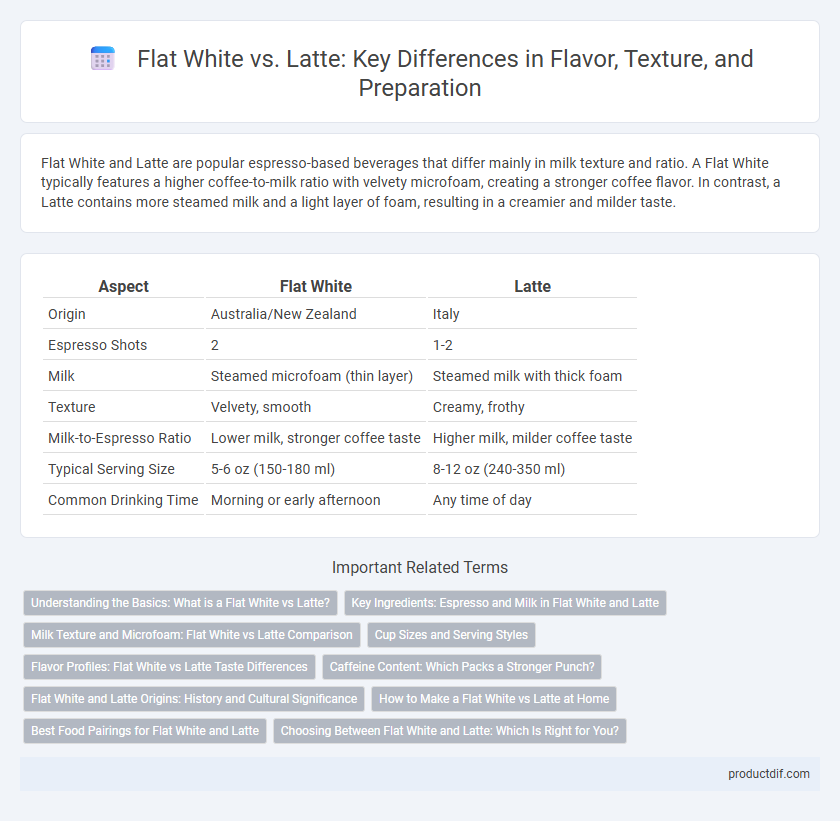Flat White and Latte are popular espresso-based beverages that differ mainly in milk texture and ratio. A Flat White typically features a higher coffee-to-milk ratio with velvety microfoam, creating a stronger coffee flavor. In contrast, a Latte contains more steamed milk and a light layer of foam, resulting in a creamier and milder taste.
Table of Comparison
| Aspect | Flat White | Latte |
|---|---|---|
| Origin | Australia/New Zealand | Italy |
| Espresso Shots | 2 | 1-2 |
| Milk | Steamed microfoam (thin layer) | Steamed milk with thick foam |
| Texture | Velvety, smooth | Creamy, frothy |
| Milk-to-Espresso Ratio | Lower milk, stronger coffee taste | Higher milk, milder coffee taste |
| Typical Serving Size | 5-6 oz (150-180 ml) | 8-12 oz (240-350 ml) |
| Common Drinking Time | Morning or early afternoon | Any time of day |
Understanding the Basics: What is a Flat White vs Latte?
A Flat White is a coffee beverage made with a double shot of espresso and steamed microfoam milk, known for its velvety texture and stronger coffee flavor. A Latte consists of a single or double espresso shot combined with a larger amount of steamed milk and a light layer of foam, resulting in a creamier and milder taste. Both drinks originate from espresso but differ in milk-to-espresso ratio and texture, influencing their flavor profiles and presentation.
Key Ingredients: Espresso and Milk in Flat White and Latte
A Flat White features a double shot of espresso combined with velvety microfoam, emphasizing a stronger coffee flavor and smoother texture. In contrast, a Latte contains a single or double shot of espresso mixed with a larger volume of steamed milk topped with light foam, creating a creamier and milder taste. The key difference lies in the milk-to-espresso ratio, where the Flat White uses less milk and finer foam, highlighting espresso richness.
Milk Texture and Microfoam: Flat White vs Latte Comparison
Flat White features a velvety microfoam with finer, denser milk texture, creating a smooth, creamy consistency that blends seamlessly with espresso. Latte has a lighter, airier milk foam with larger bubbles, resulting in a frothier texture and more pronounced milk flavor. The microfoam in a Flat White is key to its rich mouthfeel, while a Latte emphasizes a milkier profile through its thicker layer of foam.
Cup Sizes and Serving Styles
Flat White typically comes in a smaller cup size of about 5 to 6 ounces, emphasizing a stronger espresso flavor with a thin layer of microfoam. Latte is usually served in larger cups ranging from 8 to 12 ounces, featuring a higher milk-to-espresso ratio and a creamier, frothy surface. The serving style of Flat White highlights texture and intensity, while Latte prioritizes volume and smooth milk integration.
Flavor Profiles: Flat White vs Latte Taste Differences
Flat White offers a stronger coffee flavor with a bolder espresso intensity and a thinner layer of microfoam, resulting in a richer and more velvety texture. Latte presents a milder coffee taste, emphasized by larger amounts of steamed milk that create a smooth, creamy consistency with subtle sweetness. The distinct milk-to-espresso ratio in Flat White enhances the robust espresso notes, while Latte's higher milk content softens the bitterness for a gentler flavor profile.
Caffeine Content: Which Packs a Stronger Punch?
A Flat White typically contains a double shot of espresso, resulting in a higher caffeine concentration compared to a Latte, which usually features a single shot. The ratio of espresso to milk in a Flat White is higher, enhancing its caffeine intensity per volume. For caffeine enthusiasts seeking a stronger kick, the Flat White delivers a more potent boost than the creamier, milk-diluted Latte.
Flat White and Latte Origins: History and Cultural Significance
The Flat White originated in Australia and New Zealand during the 1980s, gaining popularity for its smooth texture and velvety microfoam, which contrasts with the creamier milk of a traditional latte that traces its roots back to Italy. Both beverages hold cultural significance as symbols of evolving coffee culture, with the Flat White embodying modern cafe trends in Oceania and the Latte representing classic European espresso-based drinks. Understanding their origins highlights the diverse global appreciation and adaptation of espresso with milk.
How to Make a Flat White vs Latte at Home
To make a flat white at home, start by pulling a double shot of espresso and steaming whole milk to a creamy, velvety microfoam texture without large bubbles. For a latte, use one shot of espresso with more steamed milk, creating a creamier, milkier drink topped with a lighter foam layer. The flat white emphasizes a stronger coffee flavor with less milk, while the latte offers a smoother, more diluted espresso experience.
Best Food Pairings for Flat White and Latte
Flat White pairs exceptionally well with buttery croissants, almond biscotti, and rich chocolate desserts, enhancing its velvety texture and strong espresso flavor. Latte complements lighter pastries such as fruit tarts, vanilla scones, and cinnamon rolls, balancing its creamy milkiness with subtle sweetness. Both beverages elevate brunch menus, with Flat White suited for savory items like avocado toast, while Latte harmonizes with sweet breakfast dishes.
Choosing Between Flat White and Latte: Which Is Right for You?
Choosing between a flat white and a latte depends on your preference for milk texture and coffee strength. A flat white features a higher ratio of espresso to steamed milk with velvety microfoam, offering a bold coffee flavor, while a latte contains more milk and a thicker layer of foam, providing a creamier, milder taste. Consider whether you want a rich, intense espresso experience or a smooth, milk-forward drink to find the right choice for you.
Flat White vs Latte Infographic

 productdif.com
productdif.com